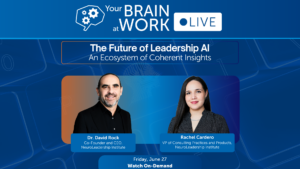Welcome to “Research Diary,” a regular peek inside NLI’s latest industry research project. Since March 2020, our Industry Research team has been interviewing HR professionals about the way they’ve experienced change and transformation efforts in their organizations.
Tackling this mammoth topic is quite timely as humankind tries to simultaneously keep up with its existing efforts, while also coming to terms with the new reality of pandemic-related disruption.
As such, leaders will need to confront many different questions moving forward, such as how organizations will adapt to changes in their business environment, how they drive and manage major transformation efforts, and the role behavior change plays.
In this new series, I want to share what we’re learning along the way. More than offering smart answers that we don’t (yet) have, I want to distill emerging, interesting themes and questions from our interviews, while still maintaining our interviewees’ complete confidentiality. The goal is to provide you and your teams with food for thought as you work through your own change efforts.
Aug 19, 2020
Hiring is vital to every organization. It builds culture, helps the organization scale, and is key to increasing diversity, an area in which many organizations could improve.
Unsurprisingly, the stakes are incredibly high. Mis-hires can be extraordinarily costly, and when a process is so integral to an organization, a rework requires a great deal of forethought and care.
Typically, that job falls to the change managers to plan how to support their employees throughout—from initial communication to long-term reinforcement. The following questions were discussed in our exploration of one organization’s hiring process rework.
1. Why is it important to continuously manage change?
Lasting change is an ongoing process, not a task to be checked off. Instead of informing employees of a change to the hiring process, many change managers work to make it clear why this change will benefit the company and explain how it aligns with established organizational standards, such as a leadership model.
As they move forward, change managers also work to help people affected by the change understand the implications it has for their day-to-day work, and equip them with the resources they need to thrive.
Pinpointing and teaching the new behaviors you want to see, like shifting interviews from 1:1 to a group format, can help make the change a new reality.
What does continuous change management mean for you?
2. What should you consider when informing those impacted by the change?
Communication certainly isn’t the only step of the change process, but it’s a very important one.
Organizations should consider not just who communicates with employees, but also how they do it. Both can make the message more or less compelling.
For example, organizations might choose to hold a meeting where a well-respected senior leader updates employees on an upcoming change in hiring processes. This choice sends the message that the change has been vetted and has buy-in at the executive level. It also creates space for employees to ask questions and gain a better understanding of what they can expect.
The timing of the communication is also a significant factor in creating a compelling message. Transparency prior to the start of a transformation can help employees align on the purpose, provide clear direction, and set expectations.
Finally, as the change effort continues, following up with employees and addressing questions throughout the process can help to reinforce the message.
When (or at which stage) do you want to start communicating to those who are affected?
3. How can tools improve the likelihood of the success of the change effort?
Once the new change initiative is communicated, employees will still need direction and support as they learn the new behaviors required for the transformation. Creating a toolkit, complete with guides, instructions, and tips can make the change easier for all involved.
When transforming a hiring process, for instance, interview styles and systems might need to be reworked. Support for this rework might mean providing them with interview guides, pre- and post-interview task lists, and clear descriptions of what to do and what not to do.
A shared understanding of what “good” looks like can even aid in the measurement of success down the road.
Which tools can you provide to enable behavior change?
[action hash= “25d5532d-1bb1-4578-ba22-76bf5f502258”]






